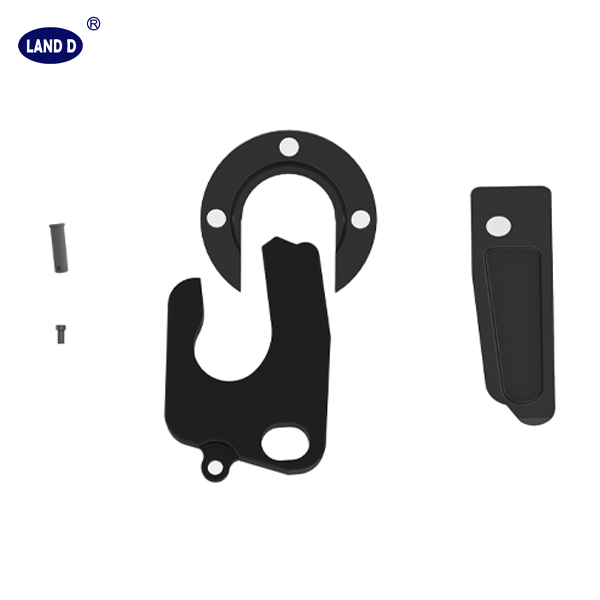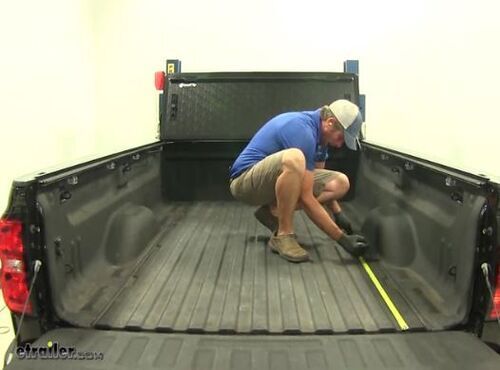4 月. 25, 2024 14:58 返回目錄
FIFTH WHEEL HITCH INSTALLATION | THE ULTIMATE DIY GUIDE Fifth Wheel
挑選完美的 第五輪 與家人共度美好時光是一個充滿樂趣和刺激的過程。您可以選擇符合您需求的戶型、您喜歡的配色方案,以及您喜歡的升級配置。但在您最終駕駛夢想中的五輪拖車上路之前,您需要考慮一個重要細節:五輪拖車掛鉤。
There are 2 types of fifth-wheel hitch setups: above-bed and below-bed—above-bed being the most common aftermarket application because they've been on the market the longest. Below-bed setups are becoming increasingly popular because they are easier to use and have a cleaner look.
您可以自行安裝第五輪掛鉤嗎?
正如您將在下文中看到的,您完全可以自行安裝第五輪拖車掛鉤。 (不過我們建議您找一兩個朋友幫忙,讓他們帶上六瓶啤酒。)這包括用於連接拖車掛鉤的軌道、用於連接到卡車車架的車架支架,以及第五輪拖車掛鉤本身。安裝過程雖然能省下一些錢,但安裝過程可能充滿挑戰。安裝第五輪拖車掛鉤最具挑戰性的部分是鑽孔。根據您購買的是定制套件還是通用套件,您可能需要在卡車車架上鑽孔。但是,無論您選擇哪種類型,都需要在卡車車廂上鑽孔才能安裝導軌。這部分操作可能會讓人望而卻步,所以如果您不放心,我們建議您聘請專業人士進行安裝。如果您之前從未嘗試過類似大型安裝,並且對此感到緊張,我們建議您在做任何決定之前先閱讀以下步驟。閱讀安裝的常規步驟希望能讓您了解此安裝是否適合您。了解基本安裝的所有步驟後,您就可以確定它是否在您的能力範圍內。如果您不確定要選擇哪種系統,也不用擔心,因為我們會在安裝指南結束後解答您關於第五輪拖車掛鉤的所有問題。我們會提供一些實用信息,例如床上和床下安裝的區別,以及定制和通用的區別。
安裝第五輪掛鉤的3個步驟:
The more detailed specifics of the installation will differ depending on your vehicle and what type of installation you choose—custom above-bed, universal above-bed, or below-bed. Below I’ll go into more detail of these 3 main steps and give you some tips you can use to make the installation process easier.以下是該過程所需的一些常用工具的清單:
免責聲明: The steps listed below are for typical installations to give you a feel for the process. This is by no means a step-by-step installation for every truck. For detailed installation steps for your truck, check the installation instructions included in the kit that you choose, or check our installation videos on the fifth-wheel kits for your truck.
- 測量並標記卡車車廂的螺栓和掛鉤附件
- 鑽出車架煞車孔(如果需要)和卡車底盤孔
- 將導軌和支架用螺栓固定到位
- 鑽頭
- 扭力扳手
- 千斤頂/升降機
- 捲尺
- 使用 舉起 will help speed up the process and make it easier for you to access the underneath of your truck. However, most people don't have access to a lift. In that case, we recommend using ramps or jacks to lift your vehicle to give you better access.
- 確保你 已經有你的第五輪掛鉤 在開始安裝之前,請先閱讀並確認,這樣可以更輕鬆地對齊和安裝導軌。這還能確保您已正確安裝導軌,並方便您進行必要的調整。
1. Measure and Mark Your Truck Bed for Bolts and Hitch Attachments
This is the easiest step of the installation, but it’s also one of the most important. In order to make sure that your fifth-wheel hitch will fit correctly in your bed, you’ll need to make sure your drilling locations you’ve measured and marked are exact.Because each truck is a little different, you should refer to your kit's detailed instructions on where exactly to measure and mark for drilling. When you set the rails in place for measurement, make sure that the rails are centered in the bed on each side, so there is equal distance between the inside edge of the bed and the outer edges of the rails. If the rails are not centered before you start drilling, you’ll have to drill new holes in your bed, which if we’re being honest, will not look great.It’s very important to double, triple, and even quadruple check your measurements to make sure that everything lines up according to your instructions. And if your bed has a drop-in liner, you’ll either have to remove it or cut it to fit, otherwise you run the risk of your holes not lining up properly with the rails.
2. Drill Out Holes for Frame Brackets (if Required) and Truck Bed Holes
Drilling into your truck, whether it’s the frame underneath or the bed, can be a little intimidating. But if you take the right precautions and follow the instructions carefully, it’s step that can be accomplished successfully.Whether or not you’ll have to drill into your truck’s frame (which can void a warranty on a new truck) depends on if you go with a custom or a universal installation. Custom fifth-wheel kits are much easier to install because they use your existing mounting holes, so you don't have to drill into your truck's frame. Unlike, universal kits, so the brackets bolt right on. We always recommend going with a custom installation if you have the option, however sometimes you don’t have a choice—mainly with older trucks.If you choose a universal kit and must drill into your truck’s frame, be sure to take your time and follow the instructions exactly.No matter which option you choose, you will have to drill into your truck bed. Once you’ve measured and marked the spots where your rails will sit, you will then have to make pilot holes where you'll install the bolts to the rails. After you’ve drilled the pilot holes, we recommend checking underneath your bed to make sure that the holes line up with the frame brackets.After your pilot holes are drilled and you’ve verified they’re in the right location, you can then enlarge the holes to the specified size.
3. Bolt the Rails and Brackets in Place
Remember how I said measuring your truck was the easiest part? Well, this might actually be the easiest part of a fifth-wheel installation. You’ve already done the hard work to jack up your truck, find the precise measurements for your rails, and drill out the holes. Now all you have to do is bolt them in place and torque them down!All your hardware should come in your installation kit, and your torqueing specifications will be in the instruction manual. Once you’ve got everything installed, there’s only one place left to go from here: out of your driveway and on the road.
We hear a lot of questions about fifth-wheel hitches: What setup should I go with? How long will it take to install? How much will it cost? How easy is each to install? Well below, we'll answer those questions for you so that you can be sure you're going with the right setup for your truck.
- Factory 5th Wheel Prep vs Aftermarket System: Determine if your truck has (or will have if you haven't bought it yet), a factory 5th-wheel prep package, or if you will be installing an aftermarket system.
- Custom vs Universal Installation: Decide if you want to drill into the frame of your truck (universal install), or if you want to only have to drill into your truck bed (custom install).
- Above-Bed vs Below-Bed Rails: Decide if you want rails permanently in your bed, or if you want a factory look with under bed rails.
Factory 5th Wheel Prep Package (Puck System)
A factory fifth-wheel prep package is something you can add on when you're purchasing your truck from a dealer. The big 3 truck manufacturers (Ford, GM, and Ram), all offer prep packages for their newer trucks capable of fifth-wheel towing. The prep package is not only a fifth-wheel hitch, but it's also a gooseneck hitch. The 4 outer holes are for attaching a specialized fifth-wheel hitch. The middle hole is for a gooseneck ball.You'll easily be able to tell if your truck already has the factory puck system in the truck bed; just look for the 5 cutouts, or pucks, in your truck bed. If you have them, great! You can get a specialty fifth-wheel hitch, or a rail adapter that's designed to drop and lock right into those pucks.Aftermarket System
If you don't have any hitch installed in your truck, you'll have to install an aftermarket fifth-wheel hitch setup, which is where the steps we listed above come in. An aftermarket setup includes frame brackets (custom or universal-fit), and above-bed or below-bed rails. Above-bed rails are universal, which means you can attach almost any standard fifth-wheel hitch to them.Reese Gooseneck Trailer Hitch Head.
From the surface, these both look exactly the same. Both universal and custom-install kits have the 2 universal base rails that are installed in your truck bed. However, it's below the bed where you'll see the difference.
Universal Installation
A universal fifth-wheel installation kit consists of two L-shaped brackets that attach to your truck's frame. You have to drill into the trucks frame to secure these brackets. Universal kits can take a lot (and I mean a lot) more time to install than a custom setup, and you'll usually need some special tools to do it. If you decide to go this route, it will typically take 5-7 hours for the complete installation, mainly because of the required drilling. However, we recommend preparing for a whole day's work, especially if you've never attempted one of these installations before.So why do people choose universal rails? Two reasons: price and limited options. Universal rails and brackets are less expensive than a custom setup, so a lot of people opt to save some cash over time convenience. Universal kits are also a very popular option for older trucks (typically early 2000's and older), because sometimes a custom-install kit isn't available.Custom Installation
With a custom-installation, however, you can just use your truck's existing pre-drilled holes to install the brackets. You'll only have to drill into the truck bed to attach the rails. A custom installation will save you a lot of time and effort, so we recommend going this route, if possible, especially when doing the install yourself. Just make sure you check our fitguide to see which custom-fit install kit is guaranteed to fit your truck.
For an aftermarket system, you can choose to have the standard rails that are bolted on top of your truck bed, or you can opt for sleeker, more convenient below-bed rails. It all depends on your personal preference and available options. Both of these options can be custom-fit for minimal drilling and an easier install. However, there are some obvious differences between the two.
Above-Bed Rails
An above-the-bed system is what you'll see in most trucks with a fifth-wheel hitch - only the brackets are installed below the bed on the frame, and there are 2 long base rails affixed to your truck bed. This is the less expensive route to go; however, you'll have to keep those big metal rails in mind when tossing cargo over your bed rail.Below-Bed Rails
On the other hand, a below-the-bed system is a very minimal, factory-looking option. There are a few different fifth-wheel manufacturers that offer these systems, including B&W (which is also a gooseneck hitch and specifically designed for their B&W Companion hitch), and Reese's below-the-bed system.You might notice that second photo of the Reese system shown above does look a lot like a factory OEM system. However, the main difference is that it only has 4 holes instead of 5, because it's only a fifth-wheel hitch, and not a fifth-wheel 和 gooseneck hitch. So, if you like the factory look of the OEM prep package, and don't mind spending a little more money, definitely go with this option if it's available for your truck.
以前的:
下一個:
最新消息
-
Unveiling the Reliability and Applications of Jost Turntables, Truck Parts, and Transport Solutions
消息Jun.25,2025
-
Exploring the Versatility of Rockinger Components and Riko Loaders
消息Jun.25,2025
-
Exploring the Mechanics and Maintenance of Jost Fifth - Wheel Systems
消息Jun.25,2025
-
Exploring the Intricacies of Fifth - Wheel Systems: A Comprehensive Guide
消息Jun.25,2025
-
Exploring Essential Components of Trailer Axle Systems and Transport Solutions
消息Jun.25,2025
-
Discovering the Multifaceted World of JOST in the Trucking Realm
消息Jun.25,2025













